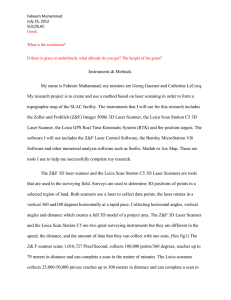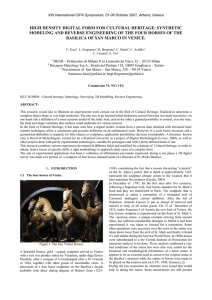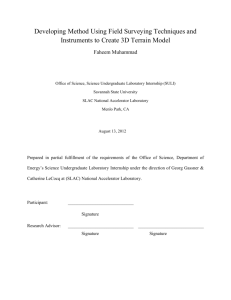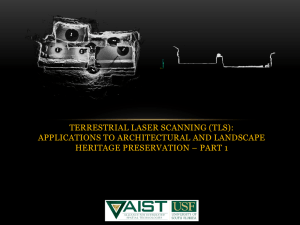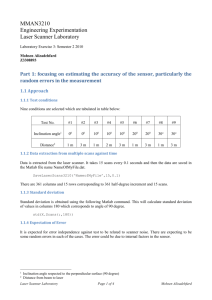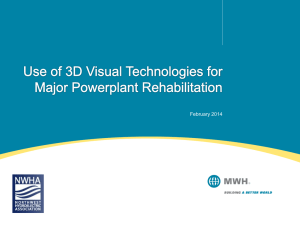Muhammad_Instruments&Methods
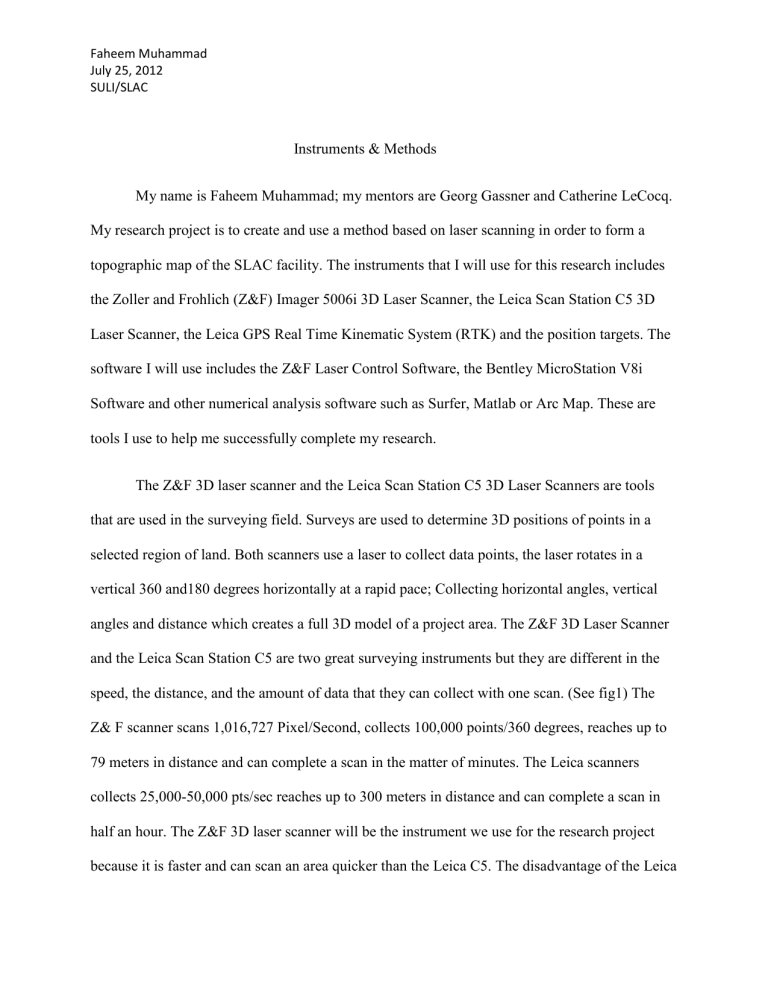
Faheem Muhammad
July 25, 2012
SULI/SLAC
Instruments & Methods
My name is Faheem Muhammad; my mentors are Georg Gassner and Catherine LeCocq.
My research project is to create and use a method based on laser scanning in order to form a topographic map of the SLAC facility. The instruments that I will use for this research includes the Zoller and Frohlich (Z&F) Imager 5006i 3D Laser Scanner, the Leica Scan Station C5 3D
Laser Scanner, the Leica GPS Real Time Kinematic System (RTK) and the position targets. The software I will use includes the Z&F Laser Control Software, the Bentley MicroStation V8i
Software and other numerical analysis software such as Surfer, Matlab or Arc Map. These are tools I use to help me successfully complete my research.
The Z&F 3D laser scanner and the Leica Scan Station C5 3D Laser Scanners are tools that are used in the surveying field. Surveys are used to determine 3D positions of points in a selected region of land. Both scanners use a laser to collect data points, the laser rotates in a vertical 360 and180 degrees horizontally at a rapid pace; Collecting horizontal angles, vertical angles and distance which creates a full 3D model of a project area. The Z&F 3D Laser Scanner and the Leica Scan Station C5 are two great surveying instruments but they are different in the speed, the distance, and the amount of data that they can collect with one scan. (See fig1) The
Z& F scanner scans 1,016,727 Pixel/Second, collects 100,000 points/360 degrees, reaches up to
79 meters in distance and can complete a scan in the matter of minutes. The Leica scanners collects 25,000-50,000 pts/sec reaches up to 300 meters in distance and can complete a scan in half an hour. The Z&F 3D laser scanner will be the instrument we use for the research project because it is faster and can scan an area quicker than the Leica C5. The disadvantage of the Leica
Faheem Muhammad
July 25, 2012
SULI/SLAC
C5 is that due to the buildings in the way of the scanner it won’t actually be able to reach the 300 meters in distance. So it would be better to use the Z&F because its range of 79 meters makes it easier to gather data point with a quicker scan [Fig1]
The next instrument is Leica GPS unit and the use of the Real Time Kinematic (RTK)
Technique. “All GPS positions are based on measuring the distance from the satellites to the
GPS receiver on earth” (1). GPS receivers transmit satellite information and use a method called triangulation to determine the user exact location” (2). Triangulation is “a way of determining something’s location by using the location of others things-” (3). An example of triangulation is
Real Time Kinematics, which uses a “radio data link to transmit satellite data from a single base station or reference point to the Leica GPS rover”. The GPS rover compares the time a signal was transmitted by a satellite with the time it was received. This allows coordinates to be calculated and displayed in real time and location as the survey is being conducted.(1)” Also we can mark the scanner position in advance with “Parker Krylon nails” or PK nails. PK nails are
“thick nails with indentation in the middle of its head” (4). For my research we will use the Leica
GPS to create coordinate points in our project area in advance to help determine the position of the Z&F 3D Laser Scanner.
Another instrument that is vital for my research is the position targets. Position targets serve as a detector tool in the process of registering scans. To register a scan means to combine multiple scan files with different views into a single data base that orient the scans into one view.
We register the scans because it eases the modeling process of an object. The method is to setup the targets in the range of the Z&F scanner so that targets can be used as a reference when scans are being registered by computer software programs.
Faheem Muhammad
July 25, 2012
SULI/SLAC
Computer software is a major part of my research. Software such as the Z&F Laser
Control, MicroStation V8i, Matlab, SURFER, and ARCMAP are used to help model the scan.
We use software from the particular function of image processing, object modeling, and data analysis. For example, the Z&F Laser Control is the software that is used data analysis and image processing to register multiple scan files into one data base to create one view of the multiple scans. MicroStation V8i software is used for object editing and modeling, image processing, and data analysis. We use software such as Matlab, SURFER, and ARCMAP use for data analysis, image processing, test and measurements, and numerical computation to create contour lines on an area of land. Contour lines connect points of equal elevation to visualize the height and the slope of the land area. This same technique is being applied to create a topography grid where engineers can view an area of land on a 2D basis in order to understand how and where to construct structures. For my research we will create contours lines of the project area and put it in the form of a topographic map.
The complete method I will use for my research project includes using the Leica GPS, the
Z&F Imager 3D laser scanner, Z&F Laser Control Software, MicroStation V8i software, Matlab,
SURFER, and ARCMAP. We will first use the Leica GPS to create coordinate points in our project area in advance to help the best determine the position of the Z&F 3d Laser Scanner. We will mark the positions with PK nails in the project area where the scanner will be placed. Once the location is mapped, next we will setup targets and perform multiple scans with the Z&F 3D
Laser Scanner at those marked positions in the project area. When the area is completely scanned, they are next exported to the Z&F Laser Control for registration. After the scans are register they are uploaded into the MicroStation V8i software where scans can be edited and modeled. After the scans are edited, Matlab, Surfer, or the Arc Map software is used to generate contour lines of
Faheem Muhammad
July 25, 2012
SULI/SLAC the project area. The contour lines are next put into the form of a topographic map which will display all dimensions of the land and location of the buildings in the project area. The purpose of my research is to use create and use this method of surveying on a small topographic map of the project area. If the research method is successful the same method will be applied to create a topographic map (see fig 2) of the entire Stanford Linear Accelerator Center (SLAC) facility. fig 2
Faheem Muhammad
July 25, 2012
SULI/SLAC
Reference Page
(1)GPS Basics, Introduction to GPS (Global Positioning Systems) Version 1.0. Switzerland: Leica, 1999.
(2)http://www8.garmin.com/aboutGPS/. n.d. 24 July 2012. <http://www8.garmin.com/aboutGPS/>.
(3)www.qrg.northwestern.edu/projects/vss/.../1-what-is-triangulation.ht... n.d. 24 July 2012.
<www.qrg.northwestern.edu>.
(4)www.valleyislesurveyors.com/FAQs.htm . n.d. 25 July 2012.
